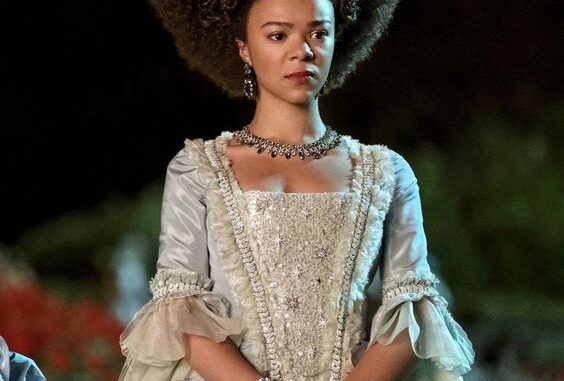
While Bridgerton chose to explain away its characters of color with a single controversial sentence, Queen Charlotte: A Bridgerton Story went a step further and decided to expand on Lady Danbury’s statement. The new Netflix series gives us a glimpse of what the two societies divided by race looked like in the days before Bridgerton. In the show, a young Charlotte (India Amarteifio) is promised to King George III (Corey Mylchreest). Upon noticing that their new Black queen will arrive in England to find a segregated society, the king’s mother, Princess Dowager Augusta (Michelle Fairley), decides to grant peerage to all Black members of the upper class. And, so, Mr. andMrs. Danbury (Cyril Nri and Arsema Thomas) become Lord and Lady Danbury. The same goes for the rest of the people of color in the British bourgeoisie.
Dubbed the Great Experiment, this unprecedented action creates problems in the world of Queen Charlotte. For instance, when Lord Danbury died, should his title be inherited by his wife and/or eldest son? The Crown just doesn’t know. Neither do audience members know how racism could be solved so quickly, with the strike of a pen. Granted, Queen Charlotte makes a show of telling us that the traditional, white aristocracy wouldn’t accept their counterparts of color so easily. It gives us characters such as Lady Vivian Ledger (Katie Brayben), who is less than okay with Black lords and ladies going to gentlemen’s clubs and throwing balls during the marriage season. However, the series also tells us that this kind of racism can be easily solved through the personal decisions of a benevolent ruler. After all, all it takes is for Queen Charlotte and King George to make an appearance at Lady Danbury’s ball for the rest of the ton to accept it as the big event of the season.
When we take into consideration that the show’s Queen Charlotte is based upon an actual theory regarding the ethnic background of the titular monarch, things get even muddier. There are indeed historians who believe that Queen Charlotte might have been Black or at least of African heritage. And, yet, in real life, this meaningful background did nothing to improve the lives of Black people living in England or its colonies.

People of Color Should Be Allowed to Exist in the ‘Bridgerton’-verse With No Further Explanations
Were there aristocrats of color in Regency England? Of course, there were. Amma Asante’s 2013 movie Belle, for instance, tells the real-life story of Dido Elizabeth Belle (Gugu Mbatha-Raw), the mixed-race daughter of a Royal Navy officer and an enslaved Black woman raised by her lord-ish uncle. However, the number of people of color that actually exists as members of the so-called ton certainly doesn’t come close to what is shown in Bridgerton or Queen Charlotte. Likewise, there was never something like Princess Augusta’s Great Experiment in British history.
This doesn’t mean that POC have no place in the Bridgerton-verse. Both Bridgerton and its spin-off are essentially a fantasy series. Not in the sense that they are ridden with magic and dragons, of course, but in the sense that they deal with our deepest fantasies instead of a semblance of reality. They cater to our desire to live swoon-worthy romances in pretty ballrooms and even prettier outfits. Let’s be honest, England doesn’t have that many dukes to throw around. They do not represent a realistic interpretation of Regency Britain, but a romance novel-like ideal based on the works of authors like Jane Austen. And POC have as much right to this fantasy as white people. By trying to approach matters of race from a realistic standpoint, Bridgerton and Queen Charlotte not only falsify history, but they also cheapen the kind of universe in which their stories are set.
Most importantly, however, by trying to tackle those issues, Van Dunsen and Rhimes introduce arguments that their shows don’t have the right framework to approach. There are plenty of shows and movies set in Regency England that go into what it was like to be a person of color in that time and place. Asante’s Belle is but one example. Based on an actual unfinished manuscript by Jane Austen, PBS’ Sanditon follows a young heiress of “West Indian” origin, played by Crystal Clarke. BBC’s fantasy miniseries Jonathan Strange & Mr. Norrell has among its central characters a Black servant, Stephen Black (Ariyon Bakare), who is prophesied to become a king. None of these movies and shows gloss over the race of their characters or try to explain away their presence with false history. They all treat the topic with respect, offering relevant discussions about bias and politics. Meanwhile, Bridgerton and Queen Charlotte, in their rushed attempt to exculpate its characters of color, do exactly the opposite, presenting viewers with shallow debates that aren’t even relevant to the story or to history, for that matter.
